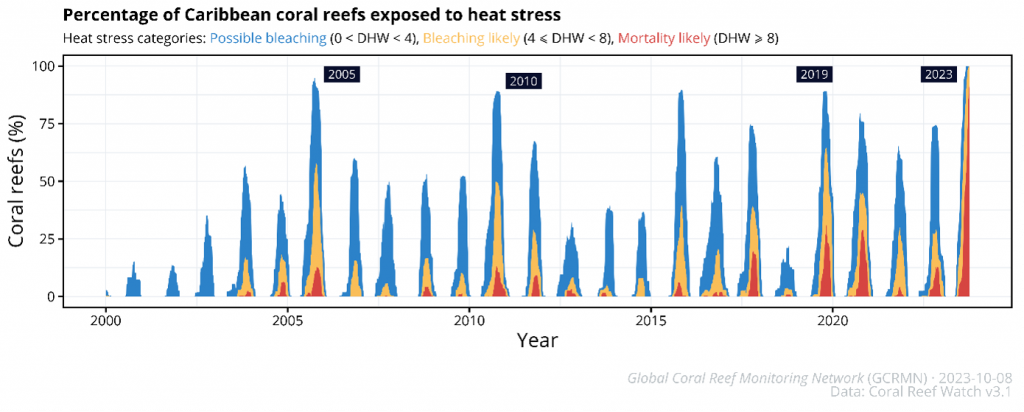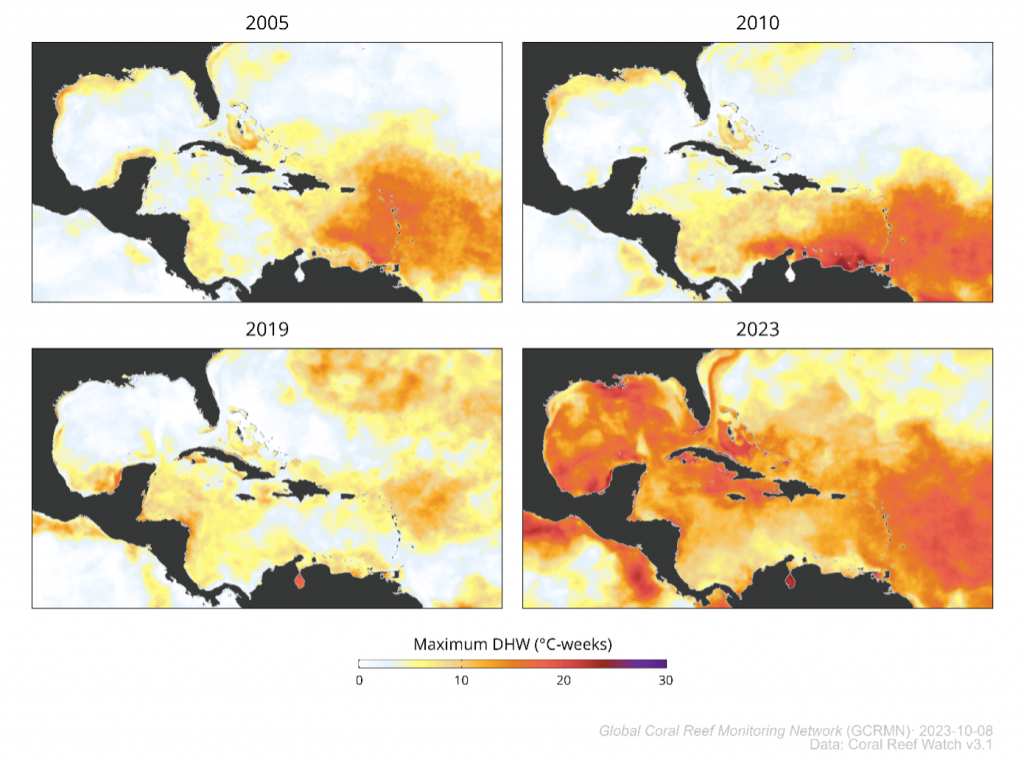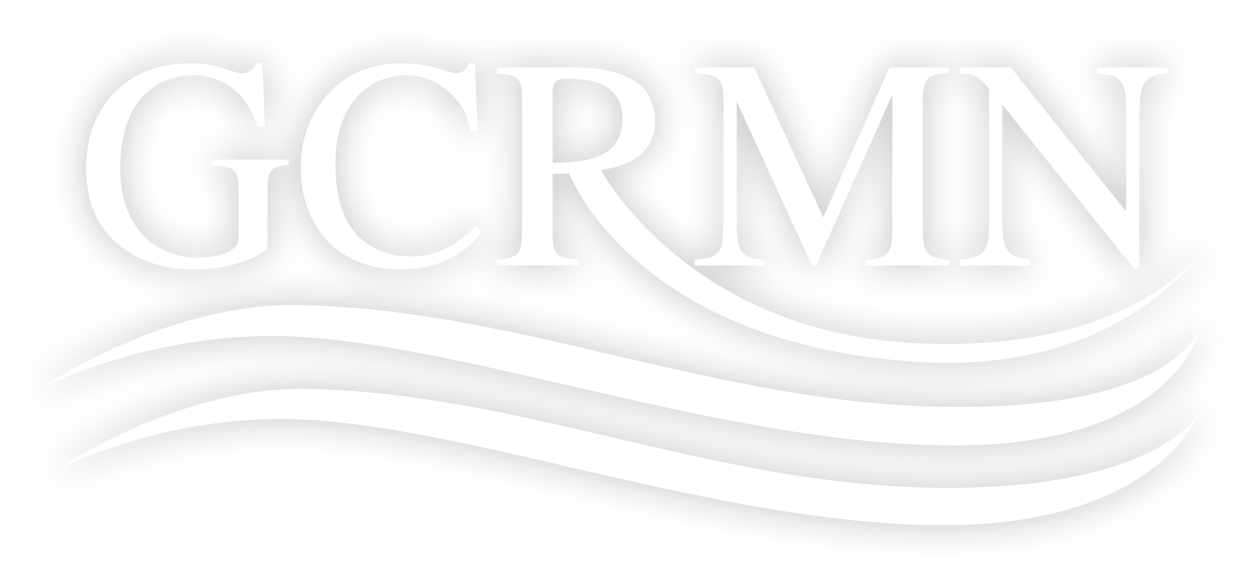Decades of overfishing, habitat destruction, and eutrophication have led to a drastic decrease of hard coral cover across coral reefs in the Caribbean (Gardner et al., 2003). In addition to these historical local stressors, coral reefs face the adverse effects of climate change, specifically the increase in frequency and extended durations of marine heat waves (Oliver et al., 2018). These marine heat waves have been identified as the major driver of hard coral cover decline at the global scale (Souter et al., 2021). Prolonged periods of high sea water temperature lead to the expulsion of a hard corals symbiotic zooxanthellate, their primary energy source, which can ultimately lead to their death (van Woesik et al., 2022).
Although it is possible to measure the impacts of marine heat waves on coral reefs by measuring change in hard coral cover over time, having an estimate of such change for an entire region requires months to years. In the shorter term, it is possible to use thresholds derived from daily sea surface temperature obtained through satellites, as a proxy of heat stress experienced by hard corals. One of the most reliable proxies of such heat stress is the Degree Heating Week, abbreviated by DHW (Van Oppen & Lough, 2018). DHW represents the cumulative heat stress to which hard corals are exposed, incorporating both intensity and duration of thermal stress. The National Oceanic and Atmospheric Administration (NOAA) provides daily maps of DHW values at the global scale, at a 5-km spatial resolution (Skirving et al., 2020). By coupling the analysis of this data with the distribution of coral reefs, it is possible to estimate the daily percentage of coral reefs experiencing heat stress.
From 2000 to 2022, the percentage of coral reefs in the Caribbean experiencing a marine heat wave (i.e. positive DHW values) was particularly high in 2005, 2010, and 2019 (Figure 1). In 2005, the percentage of Caribbean coral reefs experiencing a marine heat wave reached 94.7 % for all thermal stress categories combined, and 12.9 % for the category “Mortality likely” (Figure 1). This marine heat wave was particularly strong in the South-Eastern part of the region (Figure 2, Eakin et al., 2010). The marine heat wave of 2010 affected 89.1 % of coral reefs in the region, and 13.3 % of them experienced a “Mortality likely” category (Figure 1). The most heavily affected coral reefs were those located in the Southern part of the Caribbean (Figure 2). In 2019, the percentage of Caribbean coral reefs experiencing a marine heat wave reached 89.3 % for all thermal stress categories combined, and 30.9 % for the category “Mortality likely” (Figure 1).

The current marine heat wave occurring now is unprecedented due to two significant factors. Firstly, it marks the first marine heat wave affecting theoretically all coral reefs across the Caribbean region (Figure 1). This difference is particularly striking when comparing maps of the spatial distribution of maximum DHW values reached with the years on which regional marine heat waves occurred (Figure 2). Secondly, in 2023, the percentage of coral reefs of the Caribbean affected by the category “Mortality likely” reached 92.2 %, and the heat wave is still underway (Figure 1). This value is already three times higher than the percentage reached during the marine heat wave of 2019.

It is important to note that DHWs are not observed values of coral bleaching or mortality, but only risk thresholds for these events to occur. In addition, the spatial resolution of the data (5 km) and the limitation of satellite measurements to the upper layers of the ocean for temperature measurements partly limit the reliability of our analyses. Notably, different physical mechanisms leading to a local cooling of sea surface temperature that thus alleviate heat stress for hard corals have been described and include internal waves (Wyatt et al., 2020) or winds (Paparella et al., 2019). However, there is little doubt that the actual marine heat wave affecting coral reefs of the Caribbean is unprecedented and will likely result in major hard coral bleaching and mortality across the region. Observations of coral bleaching that have been reported since July 2023 in Florida, USA span the entire reef tract (see here). Corals in Florida have been exposed to levels of heat stress never experienced before. Multiple sites in the Lower/Middle Florida Keys have been exposed to more than two times the amount of heat stress than when mortality is expected to begin (NOAA Coral Reef Watch).
Our results demonstrate once again the urgent need to reduce greenhouses gas emissions for the preservation of coral reefs of the world, and for the communities that depend on these ecosystems for their culture and livelihoods.
References
Eakin, C. M., Morgan, J. A., Heron, S. F., Smith, T. B., Liu, G., Alvarez-, L., Baca, B., Bartels, E., Bastidas, C., Bouchon, C., Brandt, M., Andrew, W., Bunkley-williams, L., Cameron, A., Causey, B. D., Chiappone, M., Tyler, R. L., Crabbe, M. J. C., Day, O., … Williams, E. H. (2010). Caribbean Corals in Crisis: Record Thermal Stress, Bleaching, and Mortality in 2005. PLoS ONE, 5(11). https://doi.org/10.1371/journal.pone.0013969
Gardner, T. A., Côté, I. M., Gill, J. A., Grant, A., & Watkinson, A. R. (2003). Long-term region-wide declines in Caribbean corals. Science, 301(5635), 958–960. https://doi.org/10.1126/science.1086050
Liu, G., Heron, S. F., Mark Eakin, C., Muller-Karger, F. E., Vega-Rodriguez, M., Guild, L. S., de la Cour, J. L., Geiger, E. F., Skirving, W. J., Burgess, T. F. R., Strong, A. E., Harris, A., Maturi, E., Ignatov, A., Sapper, J., Li, J., & Lynds, S. (2014). Reef-scale thermal stress monitoring of coral ecosystems: New 5-km global products from NOAA coral reef watch. Remote Sensing, 6, 11579–11606. https://doi.org/10.3390/rs61111579
Oliver, E. C. J., Donat, M. G., Burrows, M. T., Moore, P. J., Smale, D. A., Alexander, L. V., Benthuysen, J. A., Feng, M., Sen Gupta, A., Hobday, A. J., Holbrook, N. J., Perkins-Kirkpatrick, S. E., Scannell, H. A., Straub, S. C., & Wernberg, T. (2018). Longer and more frequent marine heatwaves over the past century. Nature Communications, 9(1), 1–12. https://doi.org/10.1038/s41467-018-03732-9
Paparella, F., Xu, C., Vaughan, G. O., Burt, J. A., Harrison, P. L., Larkum, A. W., & Burt, J. A. (2019). Coral Bleaching in the Persian/Arabian Gulf Is Modulated by Summer Winds. Frontiers in Marine Science, 6(April), 1–15. https://doi.org/10.3389/fmars.2019.00205
Skirving, W., Marsh, B., De La Cour, J., Liu, G., Harris, A., Maturi, E., Geiger, E., & Mark Eakin, C. (2020). Coraltemp and the coral reef watch coral bleaching heat stress product suite version 3.1. Remote Sensing, 12(23), 1–10. https://doi.org/10.3390/rs12233856
Souter, D., Planes, S., Wicquart, J., Logan, M., Obura, D., & Staub, F. (2020). Status of Coral Reefs of the World: 2020. GCRMN. https://doi.org/10.59387/WOTJ9184
Van Oppen, M. J. H., & Lough, J. M. (2018). Coral Bleaching – Patterns, processes, causes and consequences. https://doi.org/10.1007/978-3-319-75393-5
van Woesik, R., Shlesinger, T., Grottoli, A. G., Toonen, R. J., Vega, R., Mark, T., Ann, E. W., Hulver, M., Chapron, L., Mclachlan, R. H., Albright, R., Crandall, E., Decarlo, T. M., Eirin-, M. K. D. J., Huang, D., Humanes, A., Krueger, T., Madin, J. S., Manzello, D., … Vega-, M. R.-L. M. (2022). Coral-bleaching responses to climate change across biological scales. Global Change Biology, 1–22. https://doi.org/10.1111/gcb.16192
Wyatt, A. S. J., Leichter, J. J., Toth, L. T., Miyajima, T., & Aronson, R. B. (2020). Heat accumulation on coral reefs mitigated by internal waves. Nature Geoscience. https://doi.org/10.1038/s41561-019-0486-4





